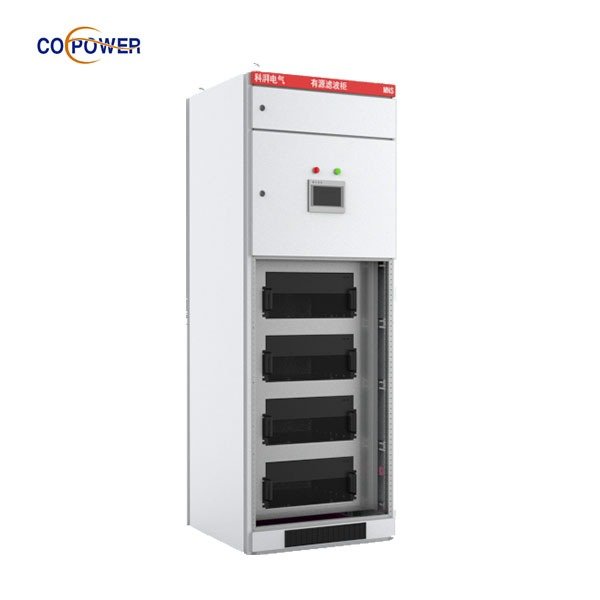En redes eléctricas modernas, especialmente aquellas que impulsan las instalaciones industriales, centros de datos, y edificios comerciales: distorsión armónica creada por cargas no lineales (como vfds, Sistemas UPS, y conductores LED) plantea un desafío significativo para la calidad de la potencia. Seleccionar la estrategia de mitigación armónica correcta es clave. Este blog se sumerge en filtros armónicos activos (AHFS) versus filtros armónicos pasivos (Phfs) y te guía sobre cuándo optar por cada uno, integrando ideas de Soluciones de filtro armónico activo de CoePower.
Filtros armónicos pasivos (Phfs)
Los PHF usan componentes tradicionales: inductores, condensadores, Resistencias: abarcadas para apuntar a frecuencias armónicas específicas. Son simples y rentables, ideal para predecible, sistemas estáticos donde el contenido armónico no varía. Pero ellos:
-Operar solo a frecuencias prediseñadas
-Puede sufrir problemas de resonancia
-Puede introducir un factor de potencia principal cuando se descarga
Filtros armónicos activos (AHFS)

Los AHF representan un moderno, solución dinámica. Controlan continuamente las perturbaciones armónicas utilizando sensores y un DSP, luego inyectar corrientes compensatorias para neutralizar esos armónicos en tiempo real
Las ventajas incluyen:
-Adaptación en tiempo real a los cambios de carga
-Dirigido a una amplia gama de armónicos
-Sin factor de potencia de liderazgo a baja carga
-Puntos de instalación flexibles (p.ej. en PCC o tableros)
Cuándo elegir un filtro pasivo
Mejor para:
-Soltero, fuentes armónicas estables, como un VFD solitario con una frecuencia conocida
-Proyectos limitados con presupuesto: costo por adelantado más bajo; menor mantenimiento
-Aplicaciones con cargas predecibles: sistemas SCADA, Unidades de motor específicas, etc..
Desventajas:
-Inflexible a los cambios en la carga del sistema
-Riesgo de resonancia e ineficiencia en diferentes condiciones
-Requiere ajuste por dispositivo: puede ser costoso si se escala
Cuándo elegir un filtro activo
Ideal para:
-Sistemas complejos con múltiples, Cargas variables: centros de datos, ambientes vegetales multi-VFD
-Aplicaciones que requieren THD ultra baja (p.ej. Límites de IEEE-519: <5–8%)—AHFS siguen siendo efectivos incluso a baja carga
-Instalaciones centralizadas (acoplamiento de punto de comunicación vs per-vfd) ofreciendo flexibilidad de instalación
-Sistemas que necesitan compensación de potencia reactiva o equilibrio trifásico
Compensaciones:
-Mayor costo inicial
-Requiere planificación y configuración calificadas
-Mantenimiento ligeramente más alto debido a la electrónica, pero ofrece un rendimiento superior a largo plazo
Filtro armónico activo de CoePower: Ventajas en el enfoque
La integración de las ideas APF de CoePower eleva esta toma de decisiones:
Mitigación armónica dinámica: Aprovecha los algoritmos DSP de alta velocidad para monitorear y compensar las corrientes armónicas en tiempo real.
Factores de forma flexible: Ofertas montadas en bastidores, montado en la pared, y opciones integradas en el gabinete para una implementación sin costuras.
Respuesta rápida & Alta precisión: Ideal para aplicaciones exigentes donde la precisión y la velocidad son primordiales.
Escalabilidad: Los diseños modulares facilitan una expansión fácil a medida que evolucionan los perfiles de carga; Perfecto para las operaciones de crecimiento.
Tabla de comparación rápida
| Criterios | Filtros armónicos pasivos (Phfs) | Filtros armónicos activos (AHFS) - |
|---|---|---|
| Mejor caso de uso | Armónicos estables de una sola fuente | Variable, sistemas de carga múltiple |
| Costo | Capex bajo, mantenimiento mínimo | Más alto Capex, costos mínimos a largo plazo |
| Adaptabilidad | Ajuste de frecuencia fija solamente | En tiempo real, compensación integral |
| Instalación | En cada fuente armónica | Colocación centralizada o flexible |
| Actuación | Adecuado para el control básico de THD | Superior a través del rango de carga, Incluso bajo carga de luz |
| Factor de potencia | Puede causar PF líder | Mantiene PF, a veces lo mejora |
| Tamaño & Modularidad | Voluminoso, por dispositivo | Compacto, modular, escalable |
| Características de coeperación | - | Basado en DSP, montaje múltiple, respuesta rápida |
Conclusión
-Los filtros pasivos brillan en simple, consciente del presupuesto, y entornos estables.
-Filtros activos, Especialmente los APF de CoePower, Excel donde fluctúan las cargas, La precisión es importante, y la escalabilidad futura es esencial.
Explore nuestra página de producto de filtro armónico activo para obtener más información:
Alineando el filtro correcto con la complejidad de su sistema, necesidades de rendimiento, e infraestructura, Usted garantiza una calidad de potencia óptima, eficiencia, y confiabilidad.
Etiquetas: Filtros armónicos activos vs pasivos, Cuándo usar filtros armónicos activos, Ventajas/desventajas del filtro armónico pasivo, Filtro armónico activo de coeperación, Estrategias de mitigación armónica, Reducción del sistema eléctrico THD, Tecnología APF basada en DSP, Filtro armónico montado en bastidor.


